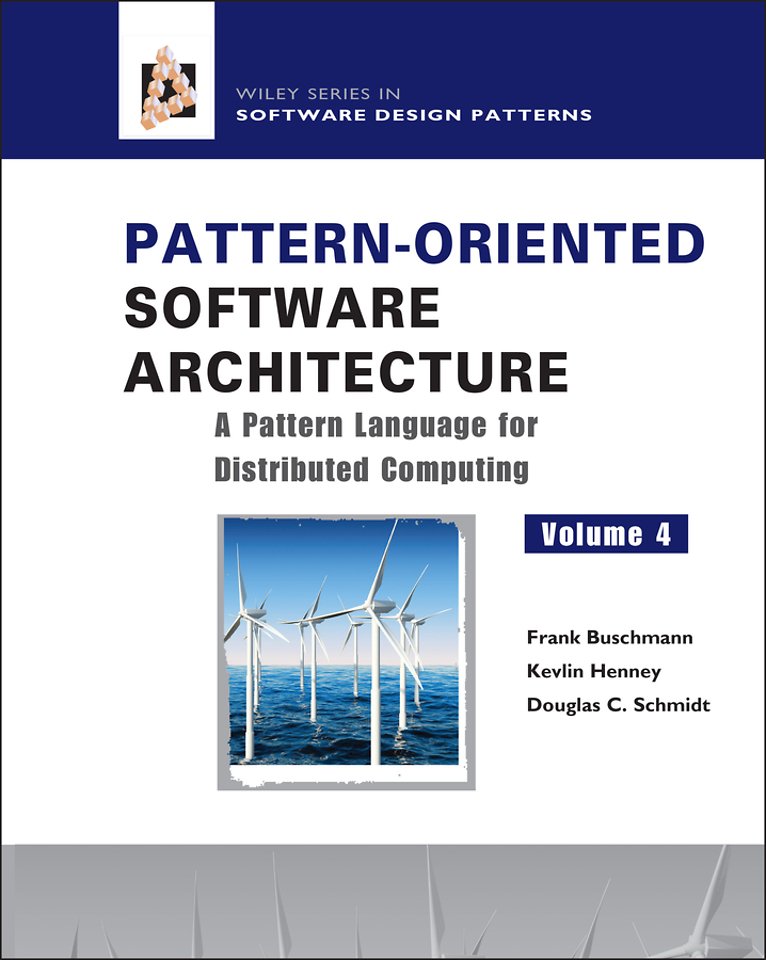Pattern-Oriented Software Architecture: A Pattern Language for Distributed Computing, Volume 4
Samenvatting
Many patterns in the software literature focus on distributes computing. Until recently, there has been no holistic view of distributed computing the emphasizes how groups of patterns complete and complement each offer. Building complex distributed systems has therefore been a craft that many have tried, but few have mastered. The eagerly anticipated 'Pattern-Oriented Software Architecture (POSA), Volume 4' provides the missing link in the development of software for distributed systems: it provides a holistic view for distributed computing.
Leading experts, Frank Buschmann, Kevlin Henney, and Douglas C. Schmidt describe a pattern language that links hundreds of patterns relevant for distributed computing. The authors guide you through the best practices in key areas of developing software for distributing computing systems. POSA 4 connects many stand-alone patterns, pattern collections, and languages from the existing body of literature found in the POSA series and other respected sources. The authors explain what patterns languages re and how to use them effectively, by comparing various patterns and distributed computing paradigms.
The material covers concepts, which provides the context of the book; a story, which describes how a real-world process control system for warehouse management was designed with the authors pattern language for distributed computing; and the language itself, which forms the main part of the book. The language addresses technical topics relevant for building distributed systems, such as:
- Object interaction
- Interface and component partitioning
- Application control
- Resource management
- Concurrency and synchronization
'POSA 4' is also the only book to offer practical advice demonstrating how to integrate pattern from key literature to provide a comprehensive pattern language for developing distributed computing middleware and applications.
Specificaties
Inhoudsopgave
About This Book
About The Authors
Guide To The Reader
PART 1: SOME CONCEPTS
1. On Patterns and Pattern Languages
1.1 Patterns Introduced
1.2 Inside Patterns
1.3 In Between Patterns
1.4 Into Pattern Languages
1.5 Patterns Connected
2. On Distributed Systems
2.1 Benefits of Distribution
2.2 Challenges of Distribution
2.3 Technologies for Supporting Distribution
2.4 Limitations with Middleware
3. On the Pattern Language.
3.1 Intent, Scope, and Audience
3.2 Origins and Genesis
3.3 Structure and Content
3.4 Presentation
3.5 Practical Use
PART 2: A STORY
4. Warehouse Management Process Control
4.1 System Scope
4.2 Warehouse Management Process Control
5. Base-line Architecture
5.1 Architecture Context
5.2 Partitioning the Big Ball of Mud
5.3 Decomposing the Layers
5.4 Accessing Domain Object Functionality
5.5 Bridging the Network
5.6 Separating User Interfaces
5.7 Distributing Functionality
5.8 Supporting Concurrent Domain Object Access
5.9 Achieving Scalable Concurrency
5.10 Crossing the Object-Oriented/Relational Divide
5.11 Configuring Domain Objects at Run-Time
5.12 Base-line Architecture Summary
6. Communication Middleware
6.1 A Middleware Architecture for Distributed Systems
6.2 Structuring the Internal Design of the Middleware
6.3 Encapsulating Low-level System Mechanisms
6.4 Demultiplexing ORB Core Events
6.5 Managing ORB Connections
6.6 Enhancing ORB Scalability
6.7 Implementing a Synchronized Request Queue
6.8 Interchangeable Internal ORB Mechanisms
6.9 Consolidating ORB Strategies
6.10 Dynamic Configuration of ORBs
6.11 Communication Middleware Summary
7. Warehouse Topology
7.1 Warehouse Topology Base-line
7.2 Representing Hierarchical Storage
7.3 Navigating the Storage Hierarchy
7.4 Modeling Storage Properties
7.5 Varying Storage Behavior
7.6 Realizing Global Functionality
7.7 Traversing the Warehouse Topology
7.8 Supporting Control Flow Extensions
7.9 Connecting to the Database
7.10 Maintaining In-Memory Storage Data
7.11 Configuring the Warehouse Topolog
7.12 Detailing the Explicit Interface
7.13 Warehouse Topology Summary
8. The Story Behind The Pattern Story.
PART 3: THE LANGUAGE
9. From Mud To Structure
Domain Model
Layers
Model-View-Controller
Presentation-Abstraction-Control
Microkernel
Reflection
Pipes and Filters
Shared Repository
Blackboard
Domain Object
10. Distribution Infrastructure
Messaging
Message Channel
Message Endpoint
Message Translator
Message Router
Publisher-Subscriber
Broker
Client Proxy
Requestor
Invoker
Client Request Handler
Server Request Handler
11. Event Demultiplexing and Dispatching
Reactor
Proactor
Acceptor-Connector
Asynchronous Completion Token
12. Interface Partitioning.
Explicit Interface
Extension Interface
Introspective Interface
Dynamic Invocation Interface
Proxy
Business Delegate
Facade
Combined Method
Iterator
Enumeration Method
Batch Method
13. Component Partitioning
Encapsulated Implementation
Whole-Part
Composite
Master-Slave
Half-Object plus Protocol
Replicated Component Group
14. Application Control
Page Controller
Front Controller
Application Controller
Command Processor
Template View
Transform View
Firewall Proxy
Authorization
15. Concurrency.
Half-Sync/Half-Async
Leader/Followers
Active Object
Monitor Object
16. Synchronization
Guarded Suspension
Future
Thread-Safe Interface
Double-Checked Locking
Strategized Locking
Scoped Locking
Thread-Specific Storage
Copied Value
Immutable Value
17. Object Interaction.
Observer
Double Dispatch
Mediator
Commando
Memento
Context Object
Data Transfer Object
Message
18. Adaptation and Extension
Bridge
Object Adapter
Chain of Responsibility
Interpreter
Interceptor
Visitor
Decorato
Execute-Around Object
Template Method
Strategy
Null Object
Wrapper Facade
Declarative Component Configuration
19. Modal Behavior
Objects for States
Methods for States
Collections for States
20. Resource Management
Container
Component Configurator
Object Manager
Lookup
Virtual Proxy
Lifecycle Callback
Task Coordinator
Resource Pool
Resource Cache
Lazy Acquisition
Eager Acquisition
Partial Acquisition
Activator
Evictor
Leasing
Automated Garbage Collection
Counting Handle
Abstract Factory
Builder
Factory Method
Disposal Method
21. Database Access
Database Access Layer
Data Mapper
Row Data Gateway
Table Data Gateway
Active Record
22. A Departing Thought
Glossary
References
Index of Patterns
Index of Names
Index
Anderen die dit boek kochten, kochten ook
Net verschenen
Rubrieken
- aanbestedingsrecht
- aansprakelijkheids- en verzekeringsrecht
- accountancy
- algemeen juridisch
- arbeidsrecht
- bank- en effectenrecht
- bestuursrecht
- bouwrecht
- burgerlijk recht en procesrecht
- europees-internationaal recht
- fiscaal recht
- gezondheidsrecht
- insolventierecht
- intellectuele eigendom en ict-recht
- management
- mens en maatschappij
- milieu- en omgevingsrecht
- notarieel recht
- ondernemingsrecht
- pensioenrecht
- personen- en familierecht
- sociale zekerheidsrecht
- staatsrecht
- strafrecht en criminologie
- vastgoed- en huurrecht
- vreemdelingenrecht









